TOYOTA TACOMA 2019 (in English) Workshop Manual
Manufacturer: TOYOTA, Model Year: 2019, Model line: TACOMA, Model: TOYOTA TACOMA 2019Pages: 700, PDF Size: 12.83 MB
Page 51 of 700
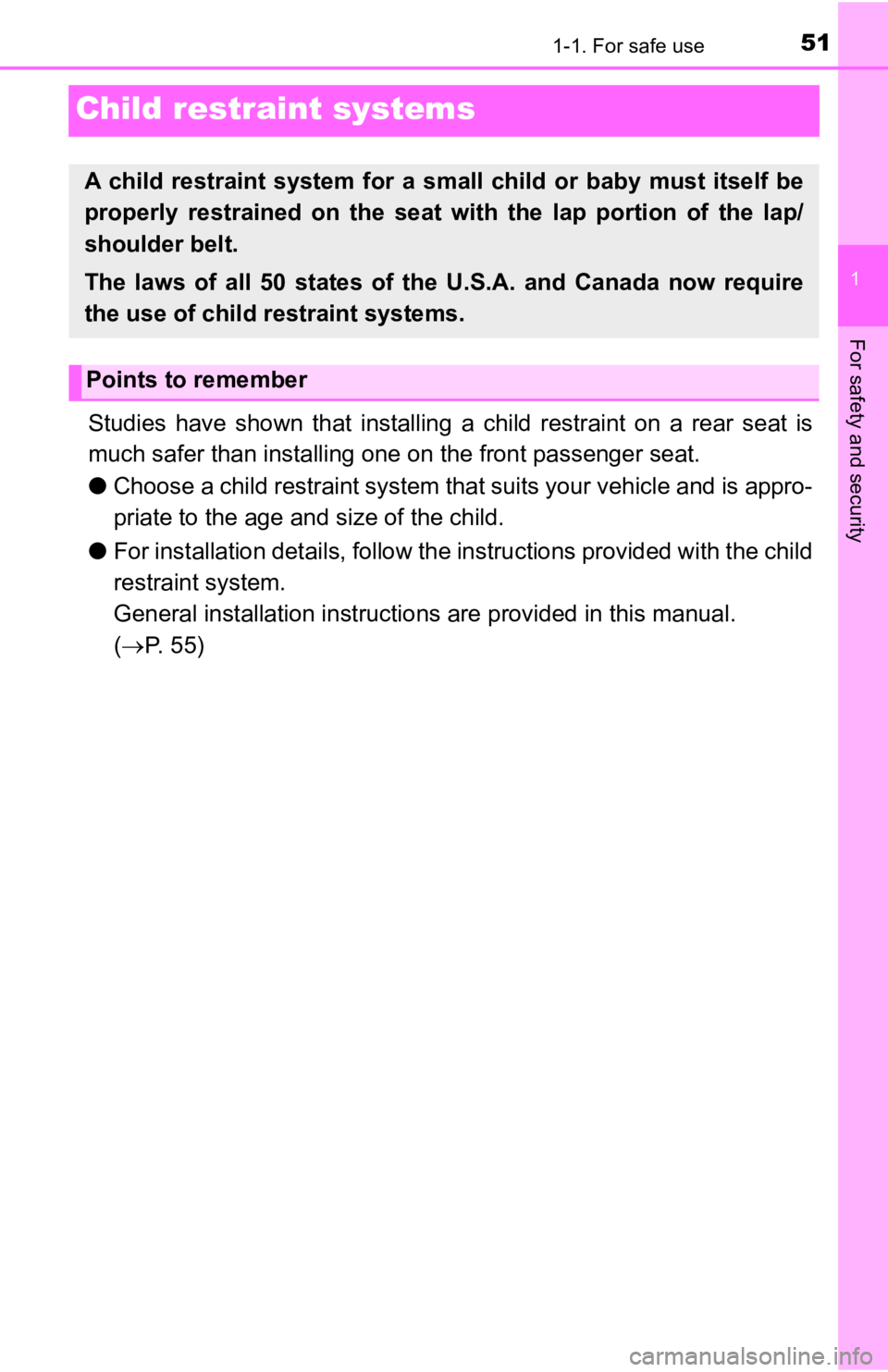
511-1. For safe use
1
For safety and security
Child restraint systems
Studies have shown that installing a child restraint on a rear seat is
much safer than installing one on the front passenger seat.
● Choose a child restraint system that suits your vehicle and is appro-
priate to the age and size of the child.
● For installation details, follow the instructions provided with the child
restraint system.
General installation instructio ns are provided in this manual.
( P. 55)
A child restraint system for a small child or baby must itself be
properly restrained on the seat with the lap portion of the lap /
shoulder belt.
The laws of all 50 states of th e U.S.A. and Canada now require
the use of child restraint systems.
Points to remember
Page 52 of 700
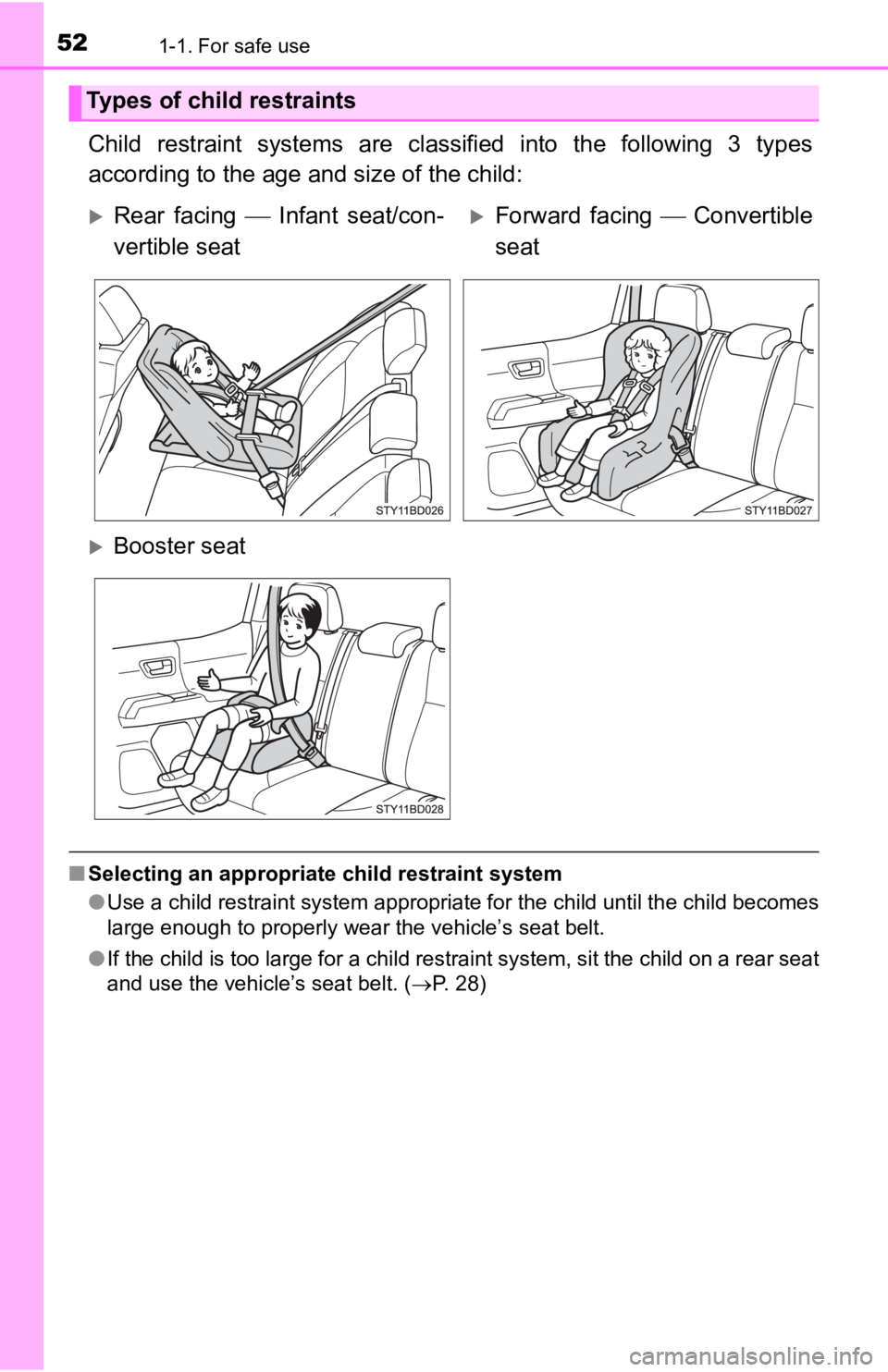
521-1. For safe use
Child restraint systems are classified into the following 3 types
according to the age a nd size of the child:
■Selecting an appropriate child restraint system
●Use a child restraint system appropriate for the child until th e child becomes
large enough to properly wear the vehicle’s seat belt.
● If the child is too large for a child restraint system, sit the child on a rear seat
and use the vehicle’s seat belt. ( P. 28)
Types of child restraints
Rear facing Infant seat/con-
vertible seatForward facing Convertible
seat
Booster seat
Page 53 of 700
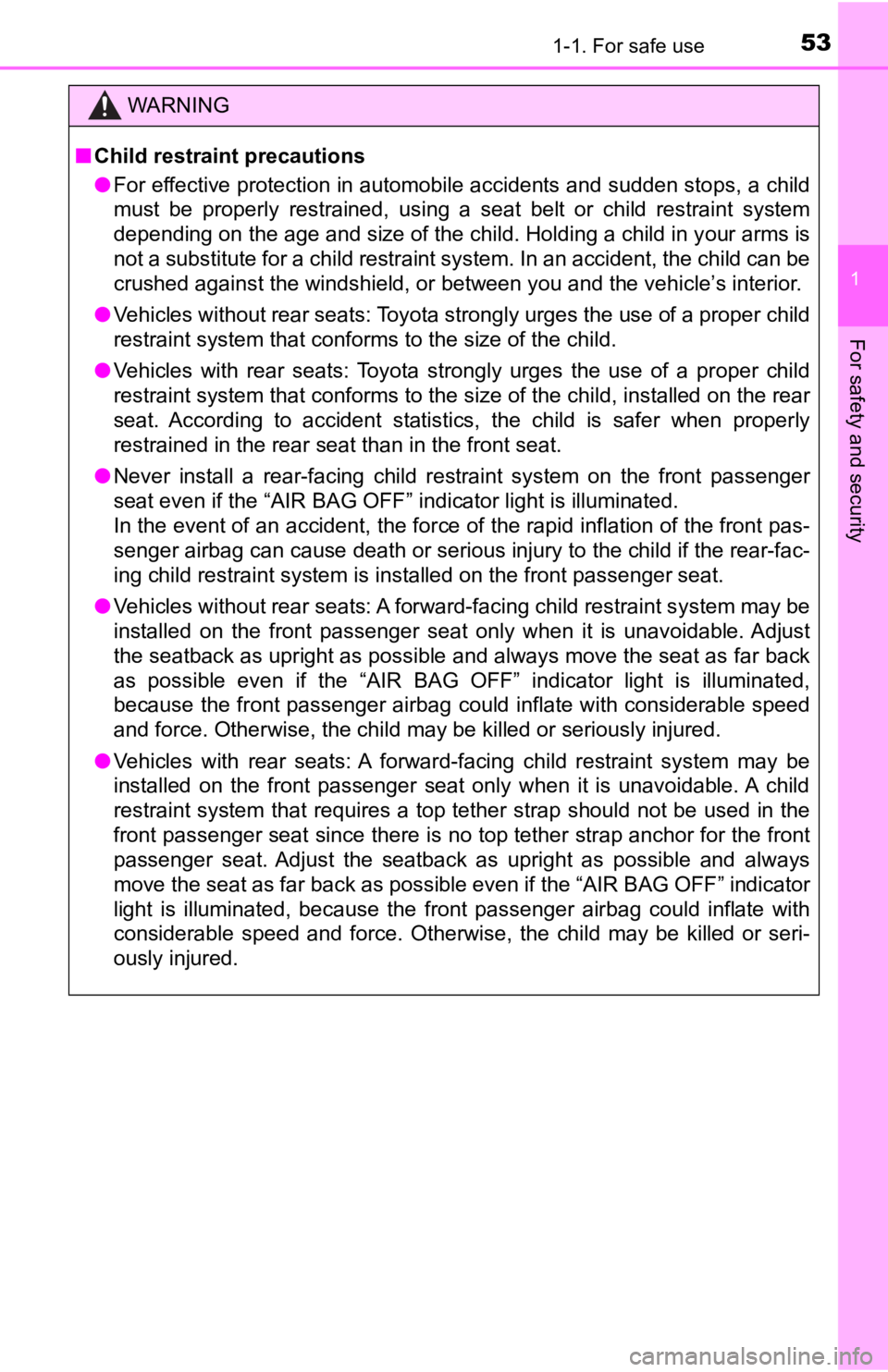
531-1. For safe use
1
For safety and security
WARNING
■Child restraint precautions
● For effective protection in automobile accidents and sudden stops, a child
must be properly restrained, using a seat belt or child restrai nt system
depending on the age and size of the child. Holding a child in your arms is
not a substitute for a child restraint system. In an accident, the child can be
crushed against the windshield, or between you and the vehicle’ s interior.
● Vehicles without rear seats: Toyota strongly urges the use of a proper child
restraint system that conforms to the size of the child.
● Vehicles with rear seats: Toyota strongly urges the use of a proper child
restraint system that conforms to the size of the child, instal led on the rear
seat. According to accident statistics, the child is safer when properly
restrained in the rear seat than in the front seat.
● Never install a rear-facing child restraint system on the front passenger
seat even if the “AIR BAG OFF” i ndicator light is illuminated.
In the event of an accident, the force of the rapid inflation of the front pas-
senger airbag can cause death or serious injury to the child if the rear-fac-
ing child restraint system is installed on the front passenger seat.
● Vehicles without rear seats: A forward-facing child restraint s ystem may be
installed on the front passenger seat only when it is unavoidab le. Adjust
the seatback as upright as possible and always move the seat as far back
as possible even if the “AIR BAG OFF” indicator light is illumi nated,
because the front passenger airbag could inflate with considerable speed
and force. Otherwise, the child may be killed or seriously injured.
● Vehicles with rear seats: A forward-facing child restraint syst em may be
installed on the front passenger seat only when it is unavoidable. A child
restraint system that requires a top tether strap should not be used in the
front passenger seat since there is no top tether strap anchor for the front
passenger seat. Adjust the seatback as upright as possible and always
move the seat as far back as possible even if the “AIR BAG OFF” indicator
light is illuminated, because the front passenger airbag could inflate with
considerable speed and force. Otherwise, the child may be kille d or seri-
ously injured.
Page 54 of 700

541-1. For safe use
WARNING
■Child restraint precautions
● Do not use the seat belt extender when installing a child restr aint system
on the front or rear passenger seat. If installing a child restraint system
with the seat belt extender connected to the seat belt, the seat belt will not
securely hold the child restraint system, which could cause dea th or seri-
ous injury to the child or other passengers in the event of an accident.
● Do not allow the child to lean his/her head or any part of his/her body
against the door or the area of the seat, front and rear pillar s or roof side
rails from which the SRS side airbags or SRS curtain shield airbags deploy
even if the child is seated in the child restraint system. It is dangerous if
the SRS side airbags and curtain shield airbags inflate, and th e impact
could cause death or serious injury to the child.
● Make sure you have complied with all installation instructions provided by
the child restraint manufacturer and that the system is properly secured. If
it is not secured properly, it may cause death or serious injury to the child
in the event of a sudden stop or an accident.
■ When children are in the vehicle
Do not allow children to play with the seat belt. If the seat belt becomes
twisted around a child’s neck, it may lead to choking or other serious injuries
that could result in death.
If this occurs and the buckle cannot be unfastened, scissors should be used
to cut the belt.
■ When the child restraint system is not in use
● Keep the child restraint system properly secured on the seat even if it is
not in use. Do not store the child restraint system unsecured in the pas-
senger compartment.
● If it is necessary to detach the child restraint system, remove it from the
vehicle. This will prevent it from injuring passengers in the event of a sud-
den stop or an accident.
Page 55 of 700
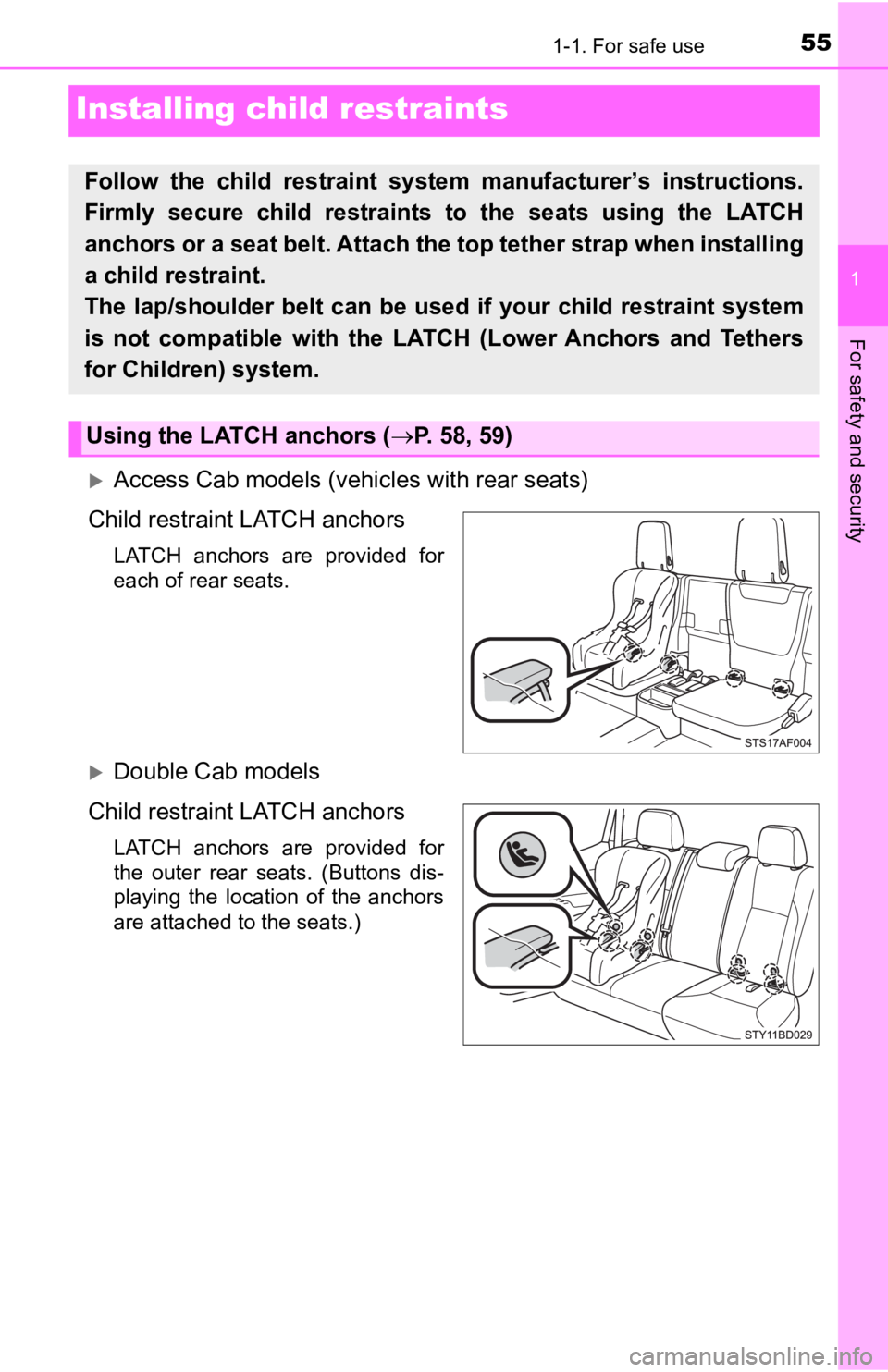
551-1. For safe use
1
For safety and security
Installing child restraints
Access Cab models (vehicles with rear seats)
Child restraint LATCH anchors
LATCH anchors are provided for
each of rear seats.
Double Cab models
Child restraint LATCH anchors
LATCH anchors are provided for
the outer rear seats. (Buttons dis-
playing the location of the anchors
are attached to the seats.)
Follow the child restraint system manufacturer’s instructions.
Firmly secure child restraints to the seats using the LATCH
anchors or a seat belt. Attach t he top tether strap when installing
a child restraint.
The lap/shoulder belt can be used if your child restraint syste m
is not compatible with the LATCH (Lower Anchors and Tethers
for Children) system.
Using the LATCH anchors ( P. 58, 59)
Page 56 of 700
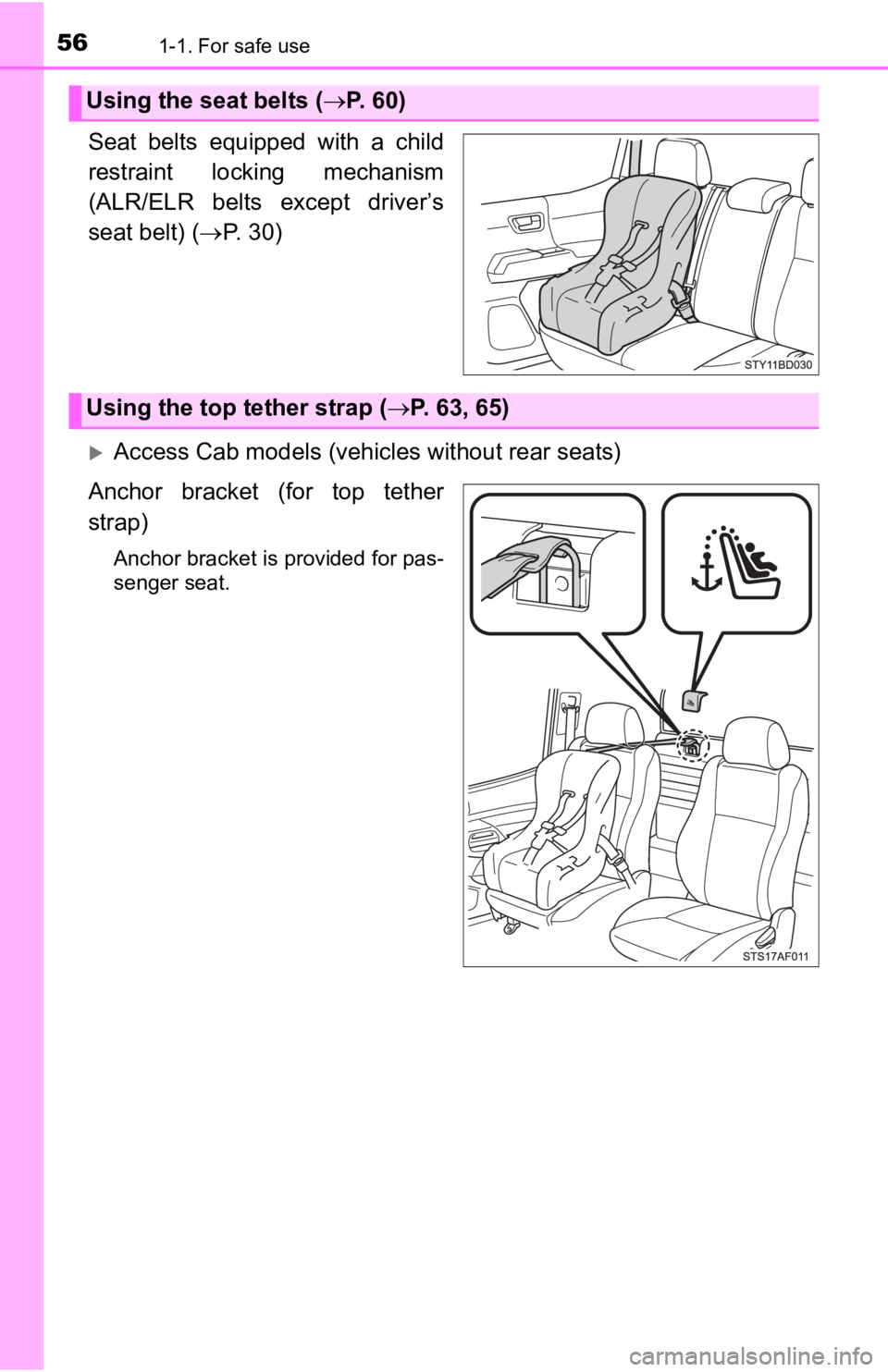
561-1. For safe use
Seat belts equipped with a child
restraint locking mechanism
(ALR/ELR belts except driver’s
seat belt) (P. 30)
Access Cab models (vehicles without rear seats)
Anchor bracket (for top tether
strap)
Anchor bracket is provided for pas-
senger seat.
Using the seat belts ( P. 6 0 )
Using the top tether strap ( P. 63, 65)
Page 57 of 700
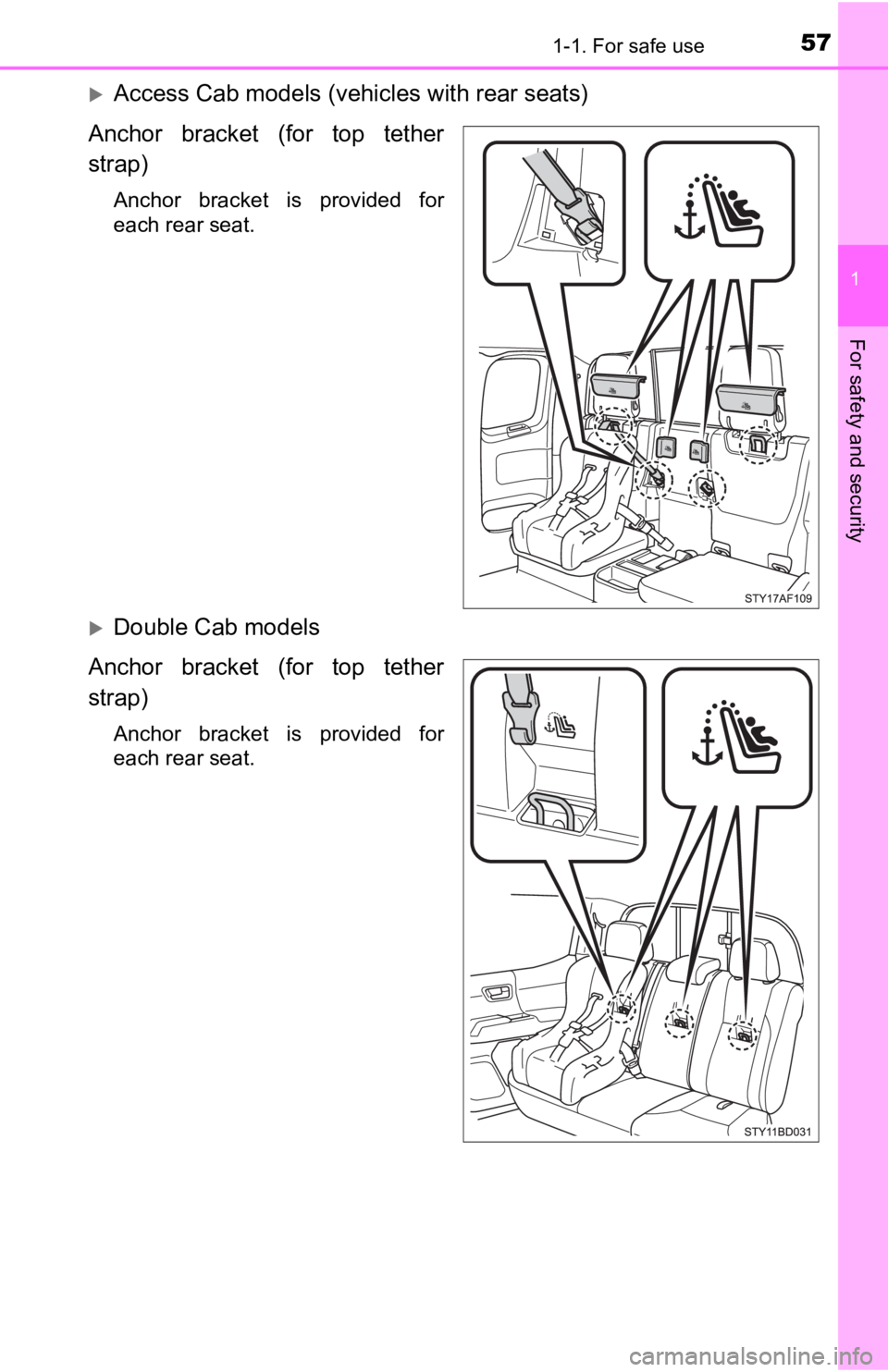
571-1. For safe use
1
For safety and security
Access Cab models (vehicles with rear seats)
Anchor bracket (for top tether
strap)
Anchor bracket is provided for
each rear seat.
Double Cab models
Anchor bracket (for top tether
strap)
Anchor bracket is provided for
each rear seat.
Page 58 of 700
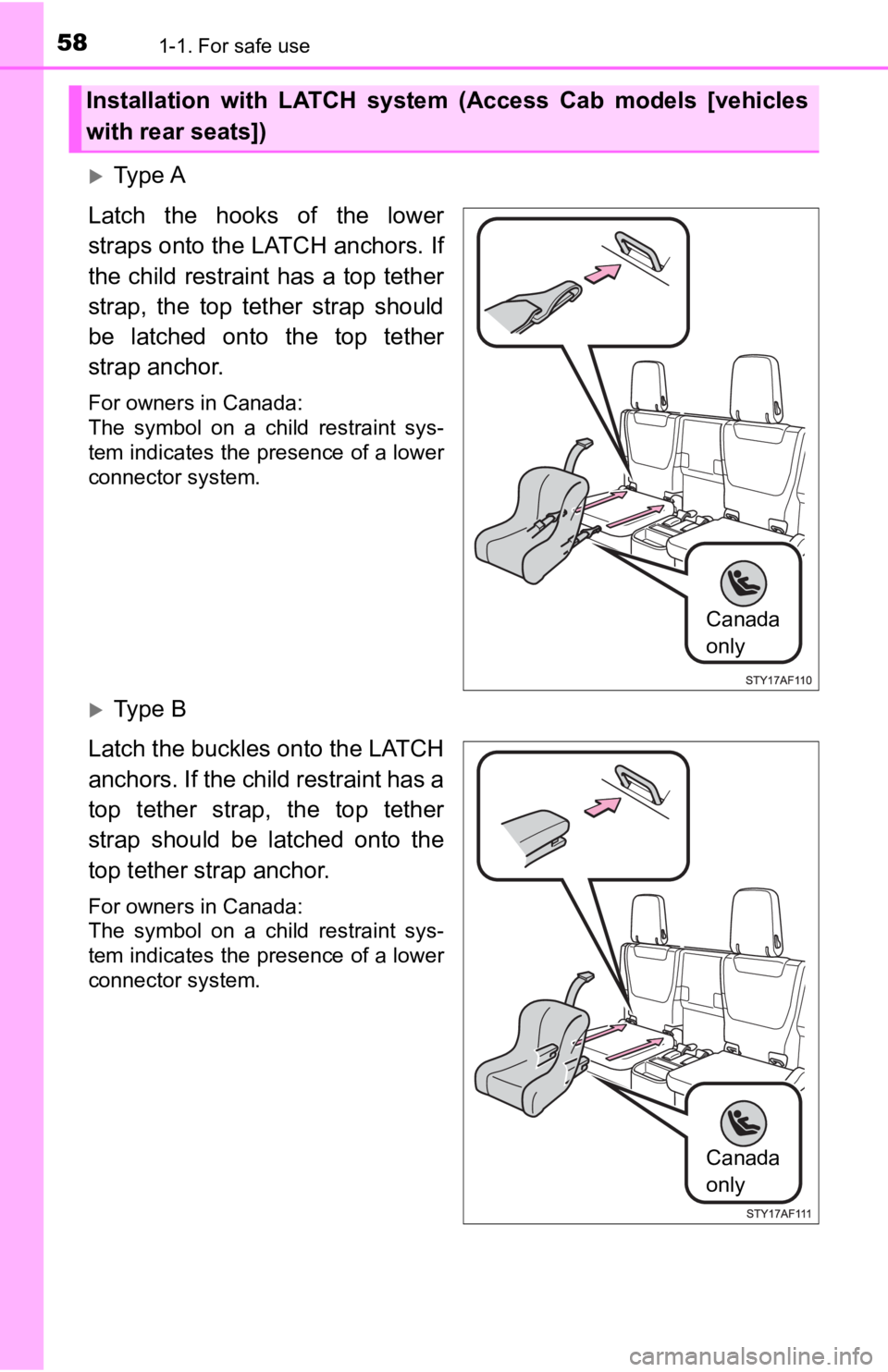
581-1. For safe use
Ty p e A
Latch the hooks of the lower
straps onto the LATCH anchors. If
the child restraint has a top tether
strap, the top tether strap should
be latched onto the top tether
strap anchor.
For owners in Canada:
The symbol on a child restraint sys-
tem indicates the presence of a lower
connector system.
Ty p e B
Latch the buckles onto the LATCH
anchors. If the child restraint has a
top tether strap, the top tether
strap should be latched onto the
top tether strap anchor.
For owners in Canada:
The symbol on a child restraint sys-
tem indicates the presence of a lower
connector system.
Installation with LATCH system (Access Cab models [vehicles
with rear seats])
Canada
only
Canada
only
Page 59 of 700
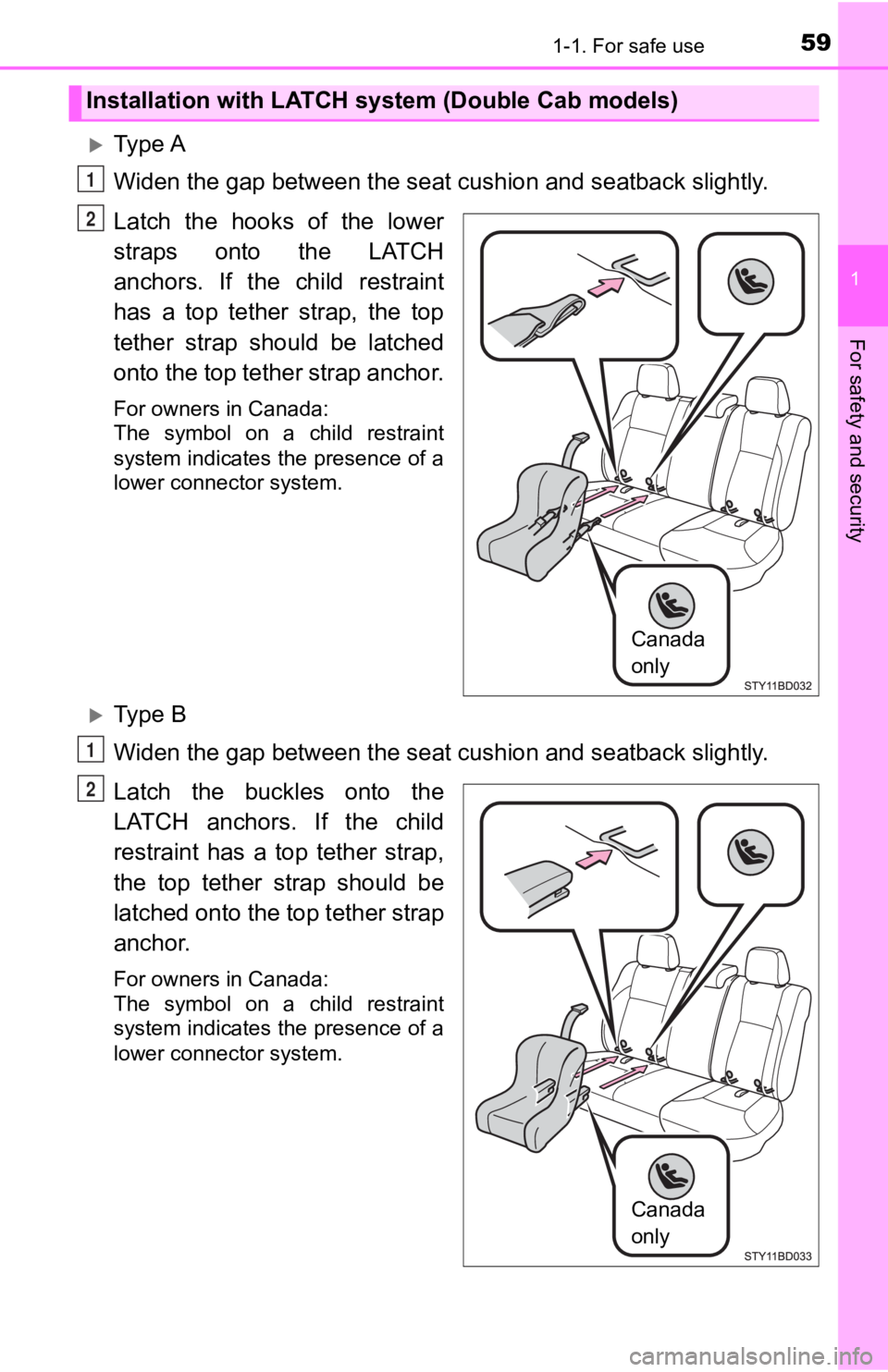
591-1. For safe use
1
For safety and security
Ty p e A
Widen the gap between the seat cushion and seatback slightly.
Latch the hooks of the lower
straps onto the LATCH
anchors. If the child restraint
has a top tether strap, the top
tether strap should be latched
onto the top tether strap anchor.
For owners in Canada:
The symbol on a child restraint
system indicates the presence of a
lower connector system.
Ty p e B
Widen the gap between the seat cushion and seatback slightly.
Latch the buckles onto the
LATCH anchors. If the child
restraint has a top tether strap,
the top tether strap should be
latched onto the top tether strap
anchor.
For owners in Canada:
The symbol on a child restraint
system indicates the presence of a
lower connector system.
Installation with LATCH system (Double Cab models)
1
Canada
only
O
N
Canada onlyCanada
only
O
Page 60 of 700
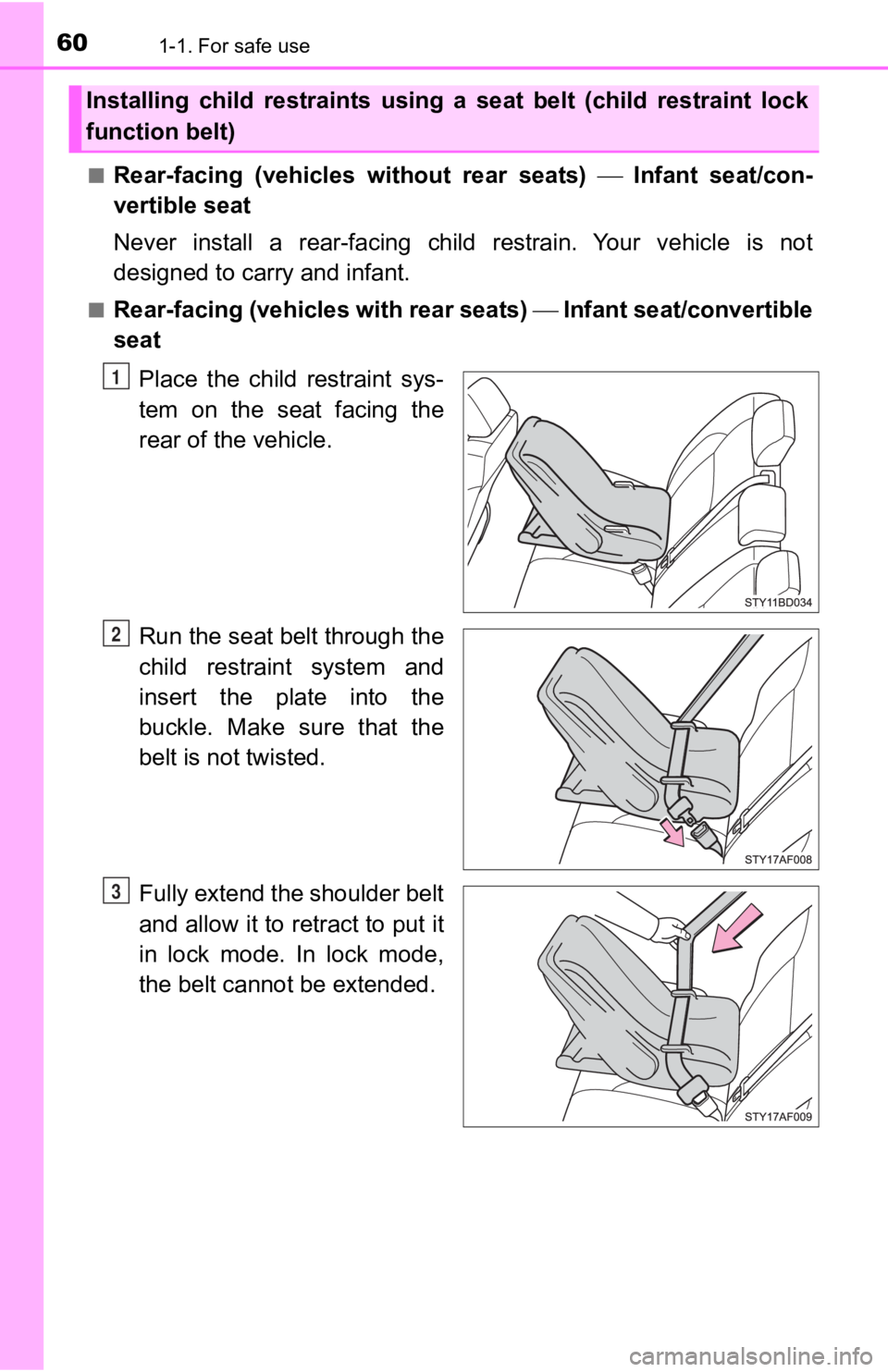
601-1. For safe use
■Rear-facing (vehicles without rear seats) Infant seat/con-
vertible seat
Never install a rear-facing child restrain. Your vehicle is not
designed to carry and infant.
■Rear-facing (vehicles with rear seats) Infant seat/convertible
seat
Place the child restraint sys-
tem on the seat facing the
rear of the vehicle.
Run the seat belt through the
child restraint system and
insert the plate into the
buckle. Make sure that the
belt is not twisted.
Fully extend the shoulder belt
and allow it to retract to put it
in lock mode. In lock mode,
the belt cannot be extended.
Installing child restraints using a seat belt (child restraint lock
function belt)
1
2
3